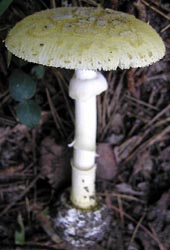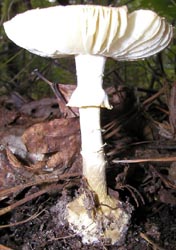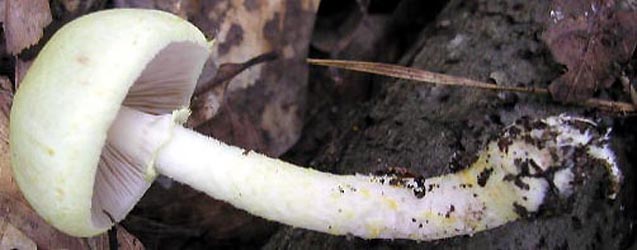|
[ Section Amanita page. ]
[ Amanita Studies home. ]
[ Keys & Checklist/Picturebooks ] "Mississippi Lemon Amanita"
Technical description (t.b.d.) BRIEF DESCRIPTION: Amanita levistriata was described by in (1988). I was lucky enough to be present for most of the collecting of the original material. The cap of A. levistriata is (22-) 31 - 37 mm wide, near ocher yellow in the center and paler yellow to colonial buff on the margin; it is hemispheric at first and becomes convex (sometimes depressed in the center). The margin is only faintly striate. The volva is present in felted patches or a fine powder that is yellowish olive against the more intensely yellow coloring of the cap. The gills are just free with a decurrent line on the upper stipe, close, white to cream, and (2-) 3 - 4.5 mm broad; the short gills are truncate, white, and of diverse lengths. The stem is 29 - 65 × (2-) 4 - 5 mm, pale yellow below and whitish or cream above the ring; the stem narrows upward, barely flaring at apex, has white flesh and is firmly stuffed or solid. It bears a basal bulb (15 - 18 × 11 - 15.5 mm) that is ovoid to turnip-shaped and sometimes markedly flattened on top. The ring is membranous, skirt-like, superior, white and finely or faintly radially striate on the top surface, while yellow and smooth below, it is thick-margined. On the base of the stem or top of the bulb, the volva appears as a ring of finely fibrillose material (lens) or very fine yellow to olive warts. The rather small spores of Amanita levistriata measure (6.5-) 7.5 - 9.5 (-10.0) × (5.5-) 6.5 - 8.0 (-9.8) µm and are subglobose to broadly ellipsoid (infrequently globose or ellipsoid) and inamyloid. Basidia lack clamps at their bases. Spores this small are most often present in semitropical to tropical species of section Amanita. This species was originally described from Mississippi, where it is known to occur in sandy soil of mixed (deciduous/coniferous) forests. It is also known from Georgia and Texas and probably can be found with oak or chestnut in adjoining coastal plain regions of the southern USA. Fruiting bodies occur singly or in small groups. Jenkins reports that the gelatinized surface layer of the cap's skin can be hard to find. This, in conjunction with the powdery warts and their placement on the cap and basal bulb suggest a volva and cap skin similar to those of such species as A. farinosa Schwein. and the recently described A. siamensis R. Sanmee et al. of southeast Asia. -- R. E. Tulloss Photos: Courtesy of Chris Matherly.
[ Section Amanita page. ]
[ Amanita Studies home. ]
[ Keys & Checklist/Picturebooks ] Last changed 8 October 2009. |




